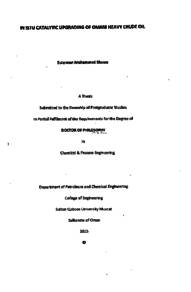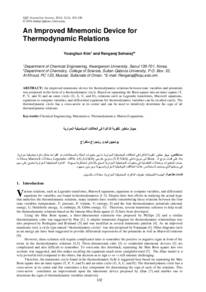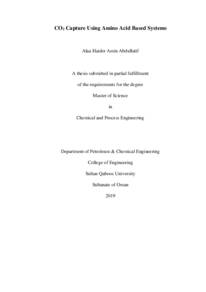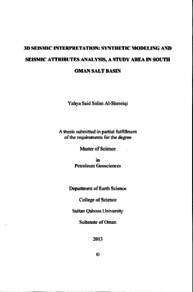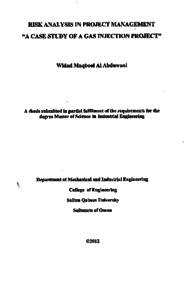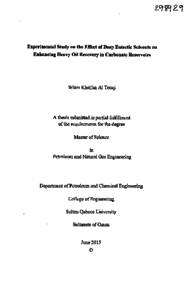وثيقة
In situ catalytic upgrading of Omani heavy crude oil
الناشر
Sultan Qaboos University
ميلادي
2015
اللغة
الأنجليزية
الملخص الإنجليزي
The major challenge in the utilization of heavy crude oil reserves is the upstream production of the oil from the reservoir at sub-surface conditions and its downstream transportation to the refinery for subsequent refining processes (due to high viscosity, low API gravity, high sulphur, nitrogen, oxygen and metals content). In situ combustion and steam injection have become the most commercially applied thermal EOR methods in the last couple of decades. Their effects increase the overall heavy oil recovery, but do not notably improve the quality of the crude. There is also strong interest in heavy crude oils mainly due to increases in worldwide energy demand and the decrease in overall quality of crude oil. Therefore, it is necessary to upgrade heavy crude oils. Recently, there is much research interest in in-situ catalytic upgrading. In this work, and for the first time, experimental investigations on the application of catalyst for enhanced recovery and upgrading of Omani heavy crude oil was conducted in the presence and absence of a porous medium. In the first phase of the study, the catalyst's performance was evaluated in a high temperature-high pressure laboratory batch reactor without a porous medium, mainly measuring the characteristics of the heavy oil while in contact with the catalysts. The reaction was conducted in the presence of hydrogen at elevated temperatures and pressures, and at static conditions with the help of a stirrer. Series of experiments were designed and then implemented to model a typical reservoir condition. A trimetallic catalyst system based on Ni, Co and Mo was used. The catalyst was introduced into the reaction media through different forms; zeolite-supported, dispersed submicron dissolved in DES and from water-in-oil emulsion. Results from the batch-reactor study showed the catalyst is effective in upgrading the heavy crude oil in terms of sulphur, coke and viscosity reduction, and API gravity increase. Solids, liquids and gaseous products formed from the upgrading experiments were recovered and characterized using FTIR and GC; for structural and compositional changes, XRD for phase and mineralogical identification, SEM-EDS for morphology and size of the solids including catalytic particles. In the second stage of the work, the recovery performance of the catalyst was investigated in the presence of a porous medium, Firstly, the recovery performance of the DES (catalyst carrier) using core flood experiments. The core flood results showed the DES has the potentials for application in chemical EOR as 16%OOIP extra oil recovery was achieved. In the second part of the recovery experiment, the catalysis effect of trimetallic dispersed submicron catalyst from water-in-oil emulsion was investigated. Experiments were conducted in a sand pack model during steam injection. Results from the recovery
experiments showed that about 15%OOIP was achieved when the catalyst was utilized compared with a blank run without a catalyst. The quality of the produced oil was also enhanced in the presence of the catalyst as a substantial reduction in sulphur and viscosity with an increase in API gravity was achieved. Overall the catalyst proved to be effective in upgrading and enhancing the recovery of the heavy crude oil. The overall work showed a novel application of trimetallic catalyst formed from molybdenum, nickel and cobalt for upgrading and enhanced recovery of the heavy crude oil. It is the first time such combination of catalyst was used in heavy oil upgrading, both at surface conditions as in the batch reactor study and the reservoir simulation as it was done in the case of steam injection in the presence of porous media. The work with the DESs for both the upgrading using the batch reactor and the oil recovery experimentation using core flooding in the presence of formation water and Berea sandstone was also first of its kind.
المجموعة
URL المصدر
الملخص العربي
هناك اهتمام متزايد في النفط الثقيل الخام ويرجع ذلك أساسا إلى الزيادة في الطلب على الطاقة في جميع أنحاء العالم والانخفاض في الجودة الشاملة من النفط الخام. وبالتالي، فمن الضروري رفع مستوى الخامات الثقيلة. في الأونة الأخيرة، هناك الكثير من الاهتمام في البحث في مجال تطوير العوامل المحفزة. في هذا العمل، أجريت تجارب بحثية على فكرة تطبيق عامل محفز لتعزيز الانتاج وتطوير النفط الخام الثقيل العماني في وجود وغياب بيئة اختيارية النفاذية. في المرحلة الأولى من الدراسة، تم تقييم أداء العامل المحفز في مفاعل دفعة ذي درجة حرارة وضغط عاليين المختبر بدون استخدام بيئة نفاذية يسهل اختراقها، والتركيز على قياس خصائص النفط الثقيل اثناء الاتصال مع المواد الحفازة. أجري التفاعل في وجود الهيدروجين في درجات حرارة وضغوط مرتفعة، وفي ظروف ثابتة باستخدام اداة مزج. وقد صممت سلسلة من التجارب ومن ثم تم تنفيذها في تصميم نموذج لحالة خزان نموذجية. تم استخدام نظام محفز بناء نموذج للمكمن بخصائص مناسبة. وتم استخدام نظام محفز ثلاثي المعدن (trimetallic ) يتكون من النيكل، والكوبالت، والمولبیدنوم. تم استخدام العامل الحفاز في الوسط التفاعلي بطرق مختلفة، المدعومة بالزيوليت، وتحت حجم الميكرون ذائبة في DES ،ومن مستحلب الماء في النفط وأظهرت نتائج الدراسة للمفاعل فعالية العامل المحفز في تطوير النفط الثقيل من ناحية كمية الكبريت، وتقليل اللزوجة ومحتوى فحم الكوك في النفط، وزيادة الجانبية (API). المواد الصلبة والسائلة والغازية التي تشكلت من تجارب التطوير تم استخلاصها ودراسة خصائصها باستخدام FTIR و GC ؛ لدراسة التغييرات الهيكلية والتركيبية XRD؛ لدراسة الحالة وتحديد التركيبة المعدنية، SEM - EDS ؛ لدراسة شكل وحجم المواد الصلبة بما في ذلك الجزيئات المحفزة. في المرحلة الثانية من العمل، تم التحقق من أداء انتاجية العوامل المحفز في وجود وسط مسامي. أولا، أداء DES (حامل العامل الحفاز) في انتعاش الانتاجية تم دراستها باستخدام التجارب الأساسية الفيضانات (core flooding). أظهرت نتائج الفيضانات الأساسية للى DES إمكانية تطبيقه في الاستخلاص المعزز للنفط الكيميائية حيث تم استخراج 16% 00IP اضافية من النفط في الجزء الثاني من تجارب الانتعاش، تم التحقق من فعالية العامل المحفز في نظام محفز ثلاثي المعدن (trimetallic ) من مستحلب الماء في النفط وأجريت التجارب في نموذج حزمة الرمال أثناء الحقن بالبخار. أظهرت نتائج تجارب الانتعاش أن حوالي 15% ooIP اضافية انتجت باستخدام المحفز مقارنة مع الحقن بالبخار بدون محفز. تم تعزيز نوعية النفط المنتج أيضا في وجود العامل الحفاز حيث نتج عنه تخفيض كبير في الكبريت واللزوجة مع زيادة في API . عموما أثبت العامل المحفز فعاليته في رفع وتعزيز انتعاش النفط الخام الثقيل.
قالب العنصر
الرسائل والأطروحات الجامعية

